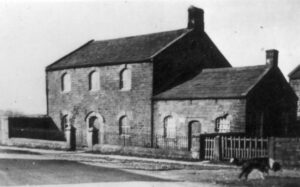Methodist Chapel
Dissenters were the first religious congregation on the Hill, formed in the 1660s and led by a former officer in Cromwell’s army, Captain Richard Freeman. After 1689, a Presbyterian meeting house was licensed in the house of Philip Harrap, who had married a daughter of Richard Freeman. The Presbyterians seem to have been the only group worshipping at Greenhow for the next fifty years, but then they began to decline with the advent of the Methodists. The chapel was pulled down about 1770. Please also see the Congregationalist Church page.
Methodism appealed to the independent spirit of the miners and quickly became established on the Hill. The early Methodists met in houses or barns. Preachers such as Thomas Lee went from place to place doing their missionary work and often faced great dangers and hardship. There was an organised mob in Pateley Bridge which attacked Lee on several occasions on his way up to Greenhow. It was not until 1812 that the Wesleyan Chapel was built at a cost of £420 and with about 50 members. By 1851, the attendance had grown to over 120, and from 1857 to 1860, the chapel was served by Rev. Joseph Kipling, who was the Superintendent Minister of the Pateley Bridge Circuit and the grandfather of the poet Rudyard Kipling.
 There is an interesting description of services at the Chapel in Eileen Whitehead’s “A Holiday at Greenhow 1918”. One service at 2 o’clock in the afternoon with 20 present and another at 6.30 with about 35 present. “We had arranged to go in the gallery”, Eileen wrote “, [and] found the seats so hard and uncomfortable, especially for girls with hats on, as the hats did not reach the top of the seat backs. The chapel is rather small but such a nice little one with a nice gallery”.
There is an interesting description of services at the Chapel in Eileen Whitehead’s “A Holiday at Greenhow 1918”. One service at 2 o’clock in the afternoon with 20 present and another at 6.30 with about 35 present. “We had arranged to go in the gallery”, Eileen wrote “, [and] found the seats so hard and uncomfortable, especially for girls with hats on, as the hats did not reach the top of the seat backs. The chapel is rather small but such a nice little one with a nice gallery”.
The Methodist Sunday School closed in 1920, and the Chapel in 1945. It stood derelict for a number of years and was finally demolished sometime in the 1950s.
Meanwhile in 1812 the Primitive Methodists broke away from the Wesleyans and in 1829 they built their own chapel at Keld Dyke. Eight members were listed in 1829. It is not known exactly when the chapel closed.
Harald Bruff wrote that this was “Henry Newbould’s house. His father built it for a chapel, and as such it was used, but when things were going back on Greenhow, it was converted first into two 2-roomed cottages and then into one (as it is at present). All the divisions except the stone division wall downstairs are made from the old pews. Its name is Chapel House”.
See also:
- St Mary’s Church
- Family History page for selected Parish Registers.